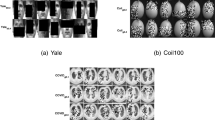Abstract
The purpose of conventional linear discriminant analysis (LDA) is to find an orientation which projects high dimensional feature vectors of different classes to a more manageable low dimensional space in the most discriminative way for classification. The LDA technique utilizes an eigenvalue decomposition (EVD) method to find such an orientation. This computation is usually adversely affected by the small sample size problem. In this paper we have presented a new direct LDA method (called gradient LDA) for computing the orientation especially for small sample size problem. The gradient descent based method is used for this purpose. It also avoids discarding the null space of within-class scatter matrix and between-class scatter matrix which may have discriminative information useful for classification.
Similar content being viewed by others
References
Fukunaga K (1990) Introduction to statistical pattern recognition. Academic Press Inc., Hartcourt Brace Jovanovich, Publishers
Swets DL, Weng J (1996) Using discriminative eigenfeatures for image retrieval. IEEE Trans. Pattern Anal Mach Intell 18(8): 831–836
Belhumeur PN, Hespanha JP, Kriegman DJ (1997) Eigenfaces vs. fisherfaces: recognition using class specific linear projection. IEEE Trans Pattern Anal Mach Intell 19(7): 711–720
Zhao W, Chellappa R, Nandhakumar N (1998) Empirical performance analysis of linear discriminant classifiers. Proc. IEEE Conf Comput Vision Pattern Recogn, 164–169
Zhao W, Chellappa R, Phillips PJ (1999) Subspace linear discriminant analysis for face recognition, Tech. Rep. CAR-TR-914, Center for Automation Research, University of Maryland, College Park
Sharma A, Paliwal KK, Onwubolu GC (2006) Class-dependent PCA, MDC and LDA: a combined classifier for pattern classification. Pattern Recogn 39(7): 1215–1229
Chen L-F, Liao H-YM, Ko M-T, Lin J-C, Yu G-J (2000) A new LDA-based face recognition system which can solve the small sample size problem. Pattern Recogn 33: 1713–1726
Yu H, Yang J (2001) A direct LDA algorithm for high-dimensional data-with application to face recognition. Pattern Recogn 34: 2067–2070
Lu J, Plataniotis KN, Venetsanopoulos AN (2003) Face recognition using LDA-based algorithms. IEEE Trans Neural Netw 14(1): 195–200
Lotlikar R, Kothari R (2000) Fractional-step dimensionality reduction. IEEE Trans Pattern Anal Mach. Intell 22(6): 623–627
Duda RO, Hart PE (1973) Pattern classification and scene analysis. Wiley, New York
Blake CL, Merz CJ (1998) UCI repository of machine learning databases,http://www.ics.uci.edu/~mlearn. University of Calif., Dept. of Information and Comp. Sci., Irvine
Magnus JR, Neudecker H (1994) Matrix differential calculus with applications in statistics and econometrics. Wiley
Author information
Authors and Affiliations
Corresponding author
Rights and permissions
About this article
Cite this article
Sharma, A., Paliwal, K.K. A Gradient Linear Discriminant Analysis for Small Sample Sized Problem. Neural Process Lett 27, 17–24 (2008). https://doi.org/10.1007/s11063-007-9056-7
Received:
Accepted:
Published:
Issue Date:
DOI: https://doi.org/10.1007/s11063-007-9056-7




